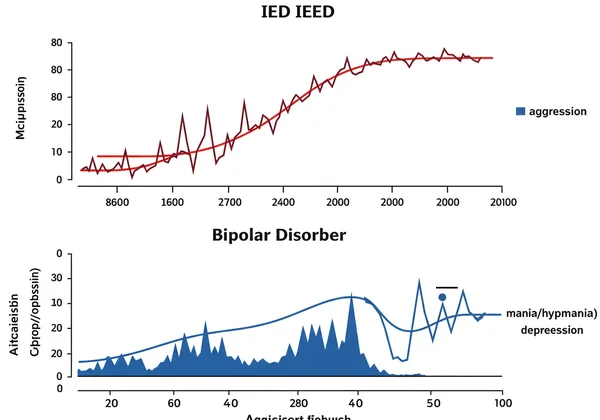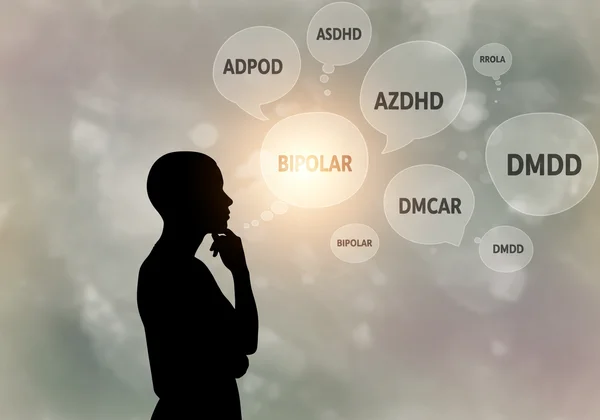IES vs. Bipolare Störung: Unterschiede bei explosiver Wut
Fühlen sich Ihre Wutausbrüche anders an als typische Stimmungsschwankungen? Fragen Sie sich, ob es sich um eine Intermittierende Explosive Störung (IES) oder etwas ganz anderes handelt? Die Überschneidung von Symptomen bei verschiedenen psychischen Erkrankungen kann die Selbstidentifikation verwirrend und überwältigend machen. Viele Menschen fragen sich: Woher weiß ich, ob ich IES habe? Dieser Leitfaden soll Klarheit schaffen.
Wir werden die nuancierten Unterschiede zwischen IES und häufig verwechselten Erkrankungen wie der Bipolaren Störung, der Borderline-Persönlichkeitsstörung (BPS), ADHS und der Störung mit disruptiver Stimmungsdysregulation (DMDD) untersuchen. Das Verständnis dieser Unterschiede kann Ihnen helfen, Ihre Erfahrungen zu verstehen und Sie zu den nächsten entscheidenden Schritten zu führen. Erste Klarheit zu gewinnen, ist ein mächtiger erster Schritt, und eine vertrauliche Wut-Selbstbeurteilung kann ein ausgezeichneter Ausgangspunkt sein.
Intermittierende Explosive Störung (IES) verstehen
Bevor wir IES mit anderen Erkrankungen vergleichen, ist es wichtig, ein klares Bild davon zu haben, was es ist. Eine Intermittierende Explosive Störung ist nicht nur ein „kurzer Zündfaden“ oder ein „schlechtes Temperament“. Es ist eine anerkannte Impulskontrollstörung, die durch wiederkehrende Verhaltensausbrüche gekennzeichnet ist, die ein Versagen der Kontrolle aggressiver Impulse darstellen. Diese Episoden können plötzlich, intensiv und grob unverhältnismäßig zur Provokation oder zum Stressor sein.
Kernsymptome & DSM-5-Diagnosekriterien
Gemäß dem Diagnostischen und Statistischen Manual Psychischer Störungen (DSM-5) umfassen die wichtigsten Diagnosekriterien für IES spezifische Muster von Ausbrüchen. Dazu gehören:
- Verbale Aggression oder nicht-destruktive körperliche Aggression: Wutanfälle, Tiraden, verbale Auseinandersetzungen oder Kämpfe, die durchschnittlich zweimal pro Woche über mindestens drei Monate auftreten.
- Destruktive oder aggressive körperliche Aggression: Drei Verhaltensausbrüche, die Sachbeschädigung oder Zerstörung von Eigentum und/oder körperliche Angriffe mit Verletzungen von Tieren oder anderen Personen innerhalb eines Zeitraums von 12 Monaten umfassen.
Entscheidend ist, dass das Ausmaß der Aggressivität, die während der wiederkehrenden Ausbrüche zum Ausdruck kommt, in einem erheblichen Missverhältnis zur Provokation steht. Diese explosiven Episoden sind nicht vorsätzlich und werden nicht begangen, um ein greifbares Ziel zu erreichen.
Die Erfahrung eines IES-Ausbruchs
Wie fühlt sich ein IES-Ausbruch also tatsächlich an? Viele Menschen beschreiben einen schnellen Aufbau von Spannung oder Erregung kurz vor einer Episode. Es kann sich anfühlen wie ein Dampfkochtopf ohne Ventil. Der Ausbruch selbst wird oft als Kontrollverlust beschrieben – eine explosive Freisetzung, die sich fast automatisch anfühlt.
Nach der Episode, die typischerweise weniger als 30 Minuten dauert, empfinden die Betroffenen oft ein Gefühl der Erleichterung. Diese Erleichterung wird jedoch schnell von intensiven Gefühlen der Reue, des Bedauerns, der Scham oder der Verlegenheit gefolgt. Dieser Zyklus aus Spannung, Explosion und Bedauern ist ein Kennzeichen der IES-Erfahrung. Wenn Ihnen dieses Muster bekannt vorkommt, könnte die Durchführung eines Tests zur intermittierenden explosiven Störung wertvolle Erkenntnisse liefern.

IES vs. Bipolare Störung: Die wichtigsten Unterschiede aufschlüsseln
Einer der häufigsten Verwechslungspunkte besteht zwischen IES und der Bipolaren Störung. Beide können Reizbarkeit und Aggression beinhalten, aber die zugrunde liegenden Mechanismen und die Präsentation sind grundlegend unterschiedlich. Das Verständnis dieser Unterschiede ist entscheidend, um die richtige Art von Unterstützung zu suchen.
Wutmuster vs. Stimmungsepisoden
Der wesentlichste Unterschied liegt in der Natur des emotionalen Zustands. IES ist durch diskrete, kurzlebige Wutmuster gekennzeichnet. Die Ausbrüche sind kurze Episoden explosiver Wut, und zwischen diesen Episoden kann die Stimmung einer Person relativ stabil oder „normal“ sein.
Die Bipolare Störung hingegen ist durch lang anhaltende Stimmungsepisoden von Manie (oder Hypomanie) und Depression definiert. Diese Episoden dauern Tage, Wochen oder sogar Monate. Während intensive Reizbarkeit und Aggression während einer manischen Episode auftreten können, sind sie Teil eines größeren Syndroms, das gehobene Stimmung, erhöhte Energie, rasende Gedanken und einen verminderten Schlafbedarf umfasst. Das explosive Verhalten bei IES ist nicht an diese anhaltenden Stimmungswechsel gebunden.

Impulsivität, Manie und Aggression bei Bipolarer Störung
Bei der Bipolaren Störung sind Impulsivität und Aggression Symptome einer zugrunde liegenden manischen oder gemischten Episode. Eine Person könnte sich rücksichtslos verausgaben, riskantes Verhalten zeigen und auch Aggressionen aufweisen. Diese Aggression wird durch den manischen Zustand angeheizt – den Größenwahn, die Reizbarkeit und das schlechte Urteilsvermögen, die damit einhergehen.
Bei IES konzentriert sich die Impulsivität auf Aggression. Die Person erlebt nicht unbedingt die gehobene Stimmung, die grenzenlose Energie oder andere Symptome der Manie. Ihre Ausbrüche sind reaktiv und explosiv und stellen ein Versagen der Wutkontrolle im Moment dar, anstatt ein Merkmal eines wochenlangen manischen Zustands zu sein.
Unterscheidung von Beginn und Kontext der Episoden
IES-Ausbrüche sind fast immer reaktiv. Sie werden durch eine geringfügige Provokation oder einen Stressor ausgelöst, der bei anderen typischerweise keine so extreme Reaktion hervorrufen würde. Die Explosion ist plötzlich und kontextabhängig.
Bipolare Stimmungsepisoden können manchmal Auslöser haben, entwickeln sich aber oft allmählicher und bleiben unabhängig von äußeren Umständen bestehen. Die Reizbarkeit in einer manischen Episode ist ein durchdringender Filter, durch den die Person die Welt über einen längeren Zeitraum betrachtet, nicht nur eine momentane Reaktion. Klarheit über Ihre persönlichen Auslöser und Muster zu gewinnen, ist ein wichtiger erster Schritt; Sie können erste Einblicke erhalten, um diesen Prozess zu beginnen.
IES von anderen häufig verwechselten Erkrankungen abgrenzen
Neben der Bipolaren Störung weisen mehrere andere Erkrankungen Merkmale mit IES auf, insbesondere in Bezug auf emotionale Kontrolle und Impulsivität. Lassen Sie uns diese kurz untersuchen.
IES vs. Borderline-Persönlichkeitsstörung (BPS)
Sowohl IES als auch BPS können intensive, unangemessene Wut beinhalten. Bei BPS ist diese Wut jedoch Teil eines viel breiteren Musters der Instabilität in zwischenmenschlichen Beziehungen, im Selbstbild und in den Emotionen. Die Wut wurzelt oft in einer tiefen Angst vor Verlassenheit und verzweifelten Bemühungen, diese zu vermeiden. Bei IES ist die explosive Wut das Hauptproblem und nicht unbedingt an diese spezifischen Beziehungsängste oder Identitätsstörungen gebunden.
IES vs. ADHS: Emotionale Dysregulation verstehen
Die Aufmerksamkeitsdefizit-/Hyperaktivitätsstörung (ADHS) wird zunehmend als eine Erkrankung verstanden, die emotionale Dysregulation beinhaltet. Dieselben Herausforderungen bei der Impulskontrolle, die die Aufmerksamkeit beeinflussen, können auch Emotionen beeinflussen und zu Frustration und Wutausbrüchen führen. Bei ADHS gehen diese emotionalen Schwierigkeiten jedoch mit Kernsymptomen der Unaufmerksamkeit und/oder Hyperaktivität-Impulsivität in verschiedenen Umgebungen einher. Die primäre Diagnose ist ADHS, wobei emotionale Ausbrüche ein damit verbundenes Merkmal sind, während bei IES die explosiven Ausbrüche das zentrale definierende Merkmal sind.
IES vs. Störung mit disruptiver Stimmungsdysregulation (DMDD)
Diese Unterscheidung ist entscheidend, wenn man Kinder und Jugendliche betrachtet. DMDD ist eine Diagnose für Personen unter 18 Jahren. Der Hauptunterschied ist die Stimmung der Person zwischen den Ausbrüchen. Kinder mit DMDD zeigen eine anhaltend reizbare oder wütende Stimmung, die für andere die meiste Zeit des Tages, fast jeden Tag, sichtbar ist. Bei IES ist die Stimmung des Individuums zwischen den Episoden nicht unbedingt durch diese anhaltende Wut gekennzeichnet.

Jenseits von Etiketten: Ihr nächster Schritt zur Klarheit
Die Komplexität explosiver Wut und emotionaler Belastung zu bewältigen, kann isolierend sein. Die Unterscheidung zwischen Erkrankungen wie IES, Bipolarer Störung und anderen geht nicht darum, sich selbst zu diagnostizieren, sondern die richtige Sprache zu finden, um Ihre Erfahrungen zu verstehen und effektive Hilfe zu suchen. Der Weg zum Wohlbefinden beginnt mit Verständnis.
Obwohl dieser Leitfaden Informationen bietet, kann er eine professionelle Diagnose nicht ersetzen. Ihre Erfahrungen sind einzigartig, und der erste Schritt zu deren Bewältigung ist, personalisierte Einblicke zu gewinnen. Wenn Sie sich in den beschriebenen Mustern wiedererkennen, ermutigen wir Sie, die kostenlose Beurteilung auf unserer Homepage durchzuführen. Es ist ein vertraulicher, verantwortungsvoller erster Schritt, um Ihre Wut und Impulsivität besser zu verstehen, und bietet Ihnen einen Ausgangspunkt für ein Gespräch mit einem qualifizierten Gesundheitsdienstleister. Sie sind nicht allein, und Klarheit ist in Reichweite.

Häufige Fragen zu Wut & Diagnose
Was ist der Hauptunterschied zwischen IES und Bipolarer Störung?
Der Hauptunterschied liegt in Dauer und Umfang. IES beinhaltet kurze, isolierte Ausbrüche explosiver Wut, mit einer relativ stabilen Stimmung dazwischen. Die Bipolare Störung beinhaltet lang anhaltende Stimmungsepisoden (Manie und Depression), die Tage oder Wochen dauern, wobei Wut nur ein mögliches Symptom eines größeren Stimmungszustands ist.
Können ADHS-Symptome mit IES verwechselt werden?
Ja, weil beide Impulsivität und emotionale Ausbrüche beinhalten können. Die Wut bei ADHS ist jedoch typischerweise Teil eines breiteren Musters emotionaler Dysregulation, Unaufmerksamkeit und Hyperaktivität. Bei IES sind die wiederkehrenden, schweren aggressiven Ausbrüche das Kern- und Definitionsmerkmal.
Woher weiß ich, ob meine Wutprobleme IES sind?
Anzeichen von IES sind wiederkehrende Wutausbrüche, die grob unverhältnismäßig zum Auslöser sind, sich unkontrollierbar anfühlen und von Reue oder Bedrängnis gefolgt werden. Um besser zu verstehen, ob Ihre Erfahrungen mit den Anzeichen von IES übereinstimmen, kann die Durchführung eines strukturierten Tests zu explosiver Wut ein hilfreicher und aufschlussreicher erster Schritt sein.
Ist es möglich, sowohl IES als auch eine andere psychische Erkrankung zu haben?
Absolut. Dies wird als Komorbidität bezeichnet. IES tritt häufig zusammen mit anderen Erkrankungen wie Depressionen, Angststörungen und Substanzgebrauchsstörungen auf. Eine umfassende Beurteilung durch einen Psychiater ist unerlässlich, um alle beitragenden Faktoren zu identifizieren.
Was sollte ich tun, wenn ich IES oder eine andere Störung vermute?
Der beste Weg ist, Informationen zu sammeln und dann professionelle Hilfe zu suchen. Ein vertrauliches Online-Tool kann Ihnen helfen, Ihre Gedanken zu ordnen und Muster zu identifizieren. Vereinbaren Sie anschließend einen Termin mit einem Therapeuten, Psychologen oder Psychiater für eine formale Diagnose und zur Besprechung eines Behandlungsplans für IES.